2. 中国建筑科学研究院, 北京 100013;
3. 陕西环境监测中心站, 陕西 西安 710054
2. China Academy of Building Research, Beijing 100013, China;
3. Shaanxi Province Environmental Monitoring Center, Xi′an 710054, China
分子印迹聚合物(Molecularly Imprinted Polymers, MIP)是对某一特定分析物在功能基团、分子尺寸、空间结构具有“记忆功能”的结合位点, 是对目标分子具有特定识别能力的合成聚合物[1]。MIP的稳定性好, 不受高温、酸碱的影响, 具有同天然生物分子识别系统(如酶和底物、抗原和抗体、受体和激素等)抵御恶劣环境影响的优点, 而且贮存条件温和, 能够长时间地保留识别性能。正因为有上述优点, MIP近年来在手性分离[2]、固相萃取[3-4]、膜分离[5]、食品[6-7]、仿生传感器[8]等领域显现出非常广阔的应用前景。
MIP的主要制备方法有:本体聚合法[9]、溶胀聚合法[10-11]、悬浮聚合法[12]、沉淀聚合法[13]等。本体聚合法操作简单、容易控制, 但后处理过程复杂, 所得颗粒聚合物的颗粒形状不规则且印迹位点在研磨过程中会有所破坏, 应用性能也较差; 溶胀聚合法所制得的产物规整性好、单分散性好, 但制备过程繁琐、周期长, 不适用于溶于水的模板分子; 悬浮聚合法制备方法简单, 但水相反应体系会影响非共价印迹聚合物的特性, 进而影响其识别性能。沉淀聚合法产率高、成本低、制备简单, 反应体系中不需要加入稳定剂或活性剂, 因而聚合物表面洁净, 从而可避免了稳定剂或活性剂对目标分子的非选择性吸附。
六硝基六氮杂异伍兹烷(CL-20), 是一种高能量密度的笼型多环硝胺结构化合物, CL-20在工业和军事领域的广泛应用使其受到越来越多研究者的关注[14]。然而杜文霞等[15]发现, CL-20在一定剂量下可能改变老鼠染色体的完整性, 并确定CL-20属于遗传毒物, 即人体长时间反复接触CL-20, 有可能导致体细胞的突变。陈松林等[16]对CL-20的热分解反应动力学进行了研究, 发现CL-20的热安定性非常好, 低温下稳定, 在70℃下的有效储存寿命为43.8年。CL-20的研制、生产、贮存、销毁等过程必定会带来一定的环境问题, 必须采取一定的措施来处理, 特别是对各个阶段所产生废水中的CL-20的处理。目前用分子印迹技术对含CL-20废水进行处理研究的工作相对较少, 故本研究采用沉淀聚合的方法, 以CL-20为模板分子制备了CL-20-MIP, 并对其结构和识别性能进行了研究,以期该印迹聚合物微球可在含能材料的废水处理、炸药纯化、爆炸品检测等方面获得应用。
2 实验部分 2.1 试剂与仪器CL-20, 辽宁庆阳特种化工有限公司; 三羟甲基丙烷三甲基丙烯酸酯(TRIM), 分析纯, 西亚试剂; 丙烯酰胺(AM), 乙腈, 95%乙醇, 甲醇, 乙酸均为分析纯, 天津市福晨化学试剂厂; 偶氮二异丁腈(AIBN), 分析纯, 天津市光复精细化工研究所。
UV-2550紫外可见分光光度计, 日本岛津公司; Quanta 200扫描电子显微镜, 荷兰FEI公司。
2.2 实验过程 2.2.1 CL-20印迹聚合物微球的制备将0.25 mmol模板分子CL-20、1.75 mmol功能单体AM和65 mL乙腈加入250 mL的烧杯中, 室温下超声振荡后静置过夜。称取5 mmolTRIM和80 mg的AIBN, 加入250 mL三口烧瓶中, 然后将烧杯中的液体转入烧瓶内, 超声脱气10 min, 再通氮气15 min, 于60 ℃搅拌, 聚合反应12 h, 反应混合物出现白色浑浊, 室温静置后, 抽滤, 用甲醇/乙酸(9/1, V/V)洗涤, 取白色粉末, 置于索式提取器中, 以丙酮为溶剂, 提取8 h, 洗脱聚合物中的模板分子及残留的单体。洗脱完毕后, 将未溶解的白色粉末于60 ℃真空干燥, 得到CL-20印迹聚合物。
非印迹聚合物(Non-molecularly imprinted polymers, NMIP)的制备方法同上, 只是反应体系中不加入模板分子CL-20。
2.2.2 CL-20和AM的相互作用表征分别配置0.03 mmol·L-1AM/乙醇溶液及0.06, 0.08, 0.10, 0.12 mmol·L-1的CL-20/乙醇溶液。分别取上述不同浓度的CL-20/乙醇各8 mL, 分别加入8 mL AM/乙醇溶液, 每间隔30 min超声5 min, 充分作用5 h后, 经紫外可见分光光度计测定在200~400 nm范围内的吸光度, 以95%乙醇做参比, 观察紫外吸收光谱的变化。
2.2.3 CL-20印迹聚合物微球吸附性能表征称取0.2 g CL-20-MIP加入到20 mL玻璃管中, 然后加入10 mL不同初始浓度的CL-20/乙醇溶液, 于室温下振荡吸附24 h, 使吸附达到平衡, 离心分离后, 取上层清液, 用紫外可见分光光度计测定在特征波长(λ=222 nm)处上清液的吸光度, 利用标准曲线计算法计算吸附前后溶液浓度的变化, 根据(1)式计算印迹聚合物对CL-20的去除率和吸附容量。
| $ {q_{\rm{e}}} = \frac{{({C_0} - {C_{\rm{e}}})\mathit{V}}}{m} $ | (1) |
式中, qe为CL-20分子印迹聚合物对CL-20的吸附容量, mg·g-1;C0为吸附前溶液中CL-20的浓度, mg·L-1;Ce为吸附后溶液中CL-20的浓度, mg·L-1;V为CL-20溶液的体积, L;m为CL-20-MIP的质量, g。
2.2.4 CL-20印迹聚合物吸附动力学取0.2 g CL-20-MIP分别置于5支20 mL玻璃管中, 加入10 mL浓度为1 mmol·L-1的CL-20/乙醇溶液, 控制温度为25 ℃, 振荡吸附, 定时取样, 测定吸附后残液的平衡浓度, 趋于不变时, 即可认为吸附达到平衡。非分子印迹聚合物的动力学同分子印迹聚合物的方法相同。
3 结果与讨论 3.1 印迹聚合物的结构 3.1.1 CL-20和AM的相互作用L-20是一种高密度多环硝胺立体笼型化合物[17]。其结构上有六个硝基, 由于硝基具有较强的吸电作用, 而AM上的氨基具有一定的供电效果, 因此, AM与CL-20之间存在较强的氢键作用。不同浓度的CL-20/乙醇溶液和AM/乙醇溶液的紫外吸收谱图见图 1。在浓度为0.03 mmol·L-1的AM/乙醇溶液中, 加入不同浓度等体积的CL-20/乙醇溶液, 充分作用后的紫外吸收谱图见图 2。
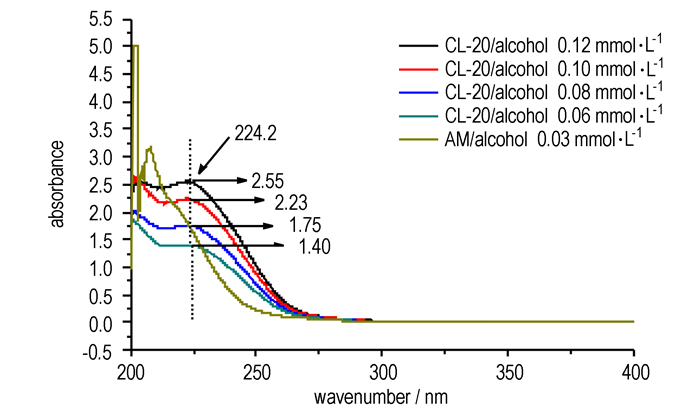
|
图 1 不同浓度的CL-20/乙醇与AM/乙醇溶液的紫外光谱图 Fig.1 UV-visible spectra of AM/alcohol and CL-20/alcohol with different concentrations |
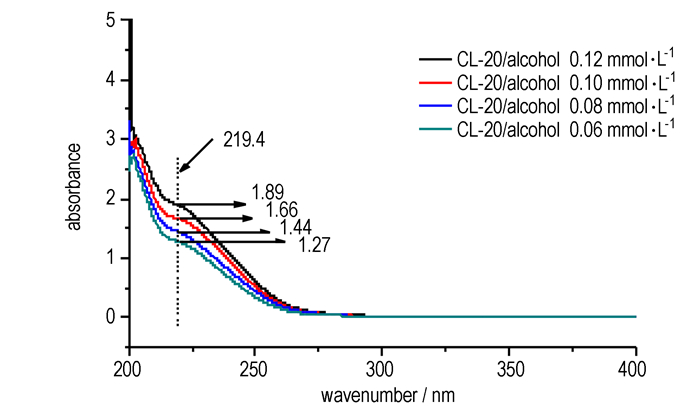
|
图 2 不同CL-20/AM比例时CL-20/AM复合物的紫外吸收光谱图 Fig.2 UV-visible spectra of CL-20/AM complex in alcohol with different AM/CL-20 ratio |
对比图 1和图 2可以看出, 在AM溶液中加入不同浓度的CL-20/乙醇溶液后, 紫外吸收的峰型变窄, 最大吸收波长从224.2 nm偏移到219.4 nm, 最大吸收峰的强度较对应浓度的CL-20溶液均有所降低, 且随着CL-20浓度的增加, 降低幅度也在增大。这主要是AM和CL-20形成复合物后, 紫外吸收出现变化, 随着AM溶液中CL-20浓度的增大, 形成的复合物浓度也随之增加, 因此吸收峰强度增加, 且波峰的波长发生红移。
以上结果证实了AM和CL-20之间存在相互作用。
3.2 CL-20印迹聚合物微球的制备通过对反应条件的优化, 本实验模板分子CL-20的用量为0.25 mmol, 功能单体AM和交联剂TRIM用量分别为1.75 mmol和5 mmol(即n(CL-20):n(AM):n(TRIM)=1:7:20), 引发剂用量为0.08 g、溶剂乙腈用量为62.5 mL、反应温度为60 ℃时所制备的MIP微球的扫描电镜结果如图 3a所示。从图 3a中可以观察到, 制得的聚合物微球球形度较好, 微球之间相互独立基本没有团聚现象, 微球粒径约为1 μm。图 3b为相同反应条件下制得的NMIP微球电镜图。从图 3b中可以看出, 微球之间存在一定的团聚现象, 微球的粒径约为2 μm。
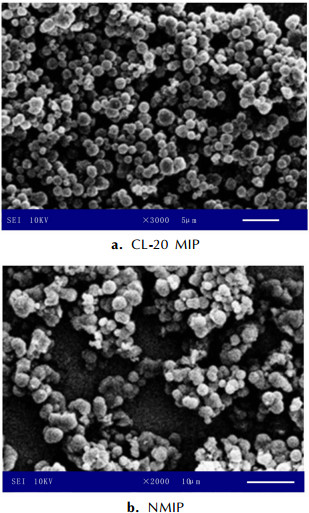
|
图 3 CL-20分子印迹和NMIP聚合物微球的电镜图 Fig.3 SEM photographs of CL-20 molecularly imprinted polymer microspheres |
分别测定了CL-20-MIP微球和NMIP微球在不同浓度的CL-20/乙醇溶液中的吸附情况, 见图 4。从图 4中可以看出, CL-20-MIP相对NMIP具有较强的特异性识别能力和较高的吸附量, MIP的平衡吸附量为14.02 mg·g-1, NMIP的平衡吸附量为6.67 mg·g-1, MIP对CL-20的吸附量为NMIP的2.1倍。NMIP对CL-20的吸附量是由表面物理吸附决定, 而MIP的吸附量取决于非特异性吸附和特异性吸附, 以特异性吸附为主, 特异性吸附是由印迹空穴和结合位点共同作用而决定。
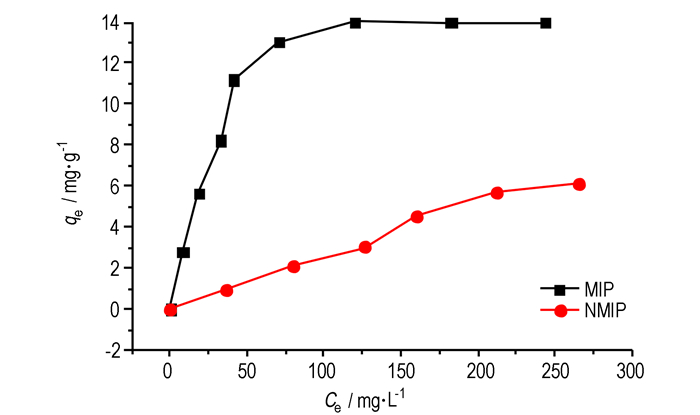
|
图 4 CL-20印迹聚合物和非印迹聚合物的等温吸附曲线 Fig.4 Adsorption isotherm of CL-20-MIP and CL-20-NMIP for binding |
图 5和图 6分别为CL-20分子印迹聚合物和非印迹聚合物的Langmuir吸附等温线和Freundlich吸附等温线。
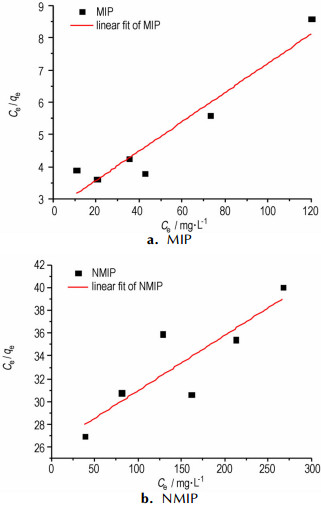
|
图 5 CL-20分子印迹聚合物和非印迹聚合物的Langmuir吸附等温线 Fig.5 Langmuir isotherms of CL-20 to MIP and NMIP |
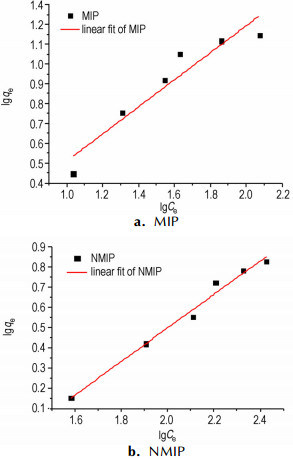
|
图 6 CL-20分子印迹聚合物和非印迹聚合物的Freundlich吸附等温线 Fig.6 Freundlich isotherm of CL-20 to MIP and NMIP |
| $ {\rm{Langmuir吸附等温方程为}}:\frac{{{C_{\rm{e}}}}}{{{q_{\rm{e}}}}} = \frac{{{C_{\rm{e}}}}}{{{q_{\rm{m}}}}} + \frac{1}{{(k \cdot {q_{\rm{m}}})}} $ | (2) |
| $ {\rm{Freundlich吸附等温方程为}}:\lg {q_{\rm{e}}} = \lg {k_{\rm{f}}} + \frac{1}{n}\lg {C_{\rm{e}}} $ | (3) |
式中,qe为平衡吸附量,mg·g-2; qm为饱和吸附量, mg·g-1; k为吸附平衡常数; Ce为吸附达到平衡后CL-20的浓度, mg·L-1; kf为Freundlich吸附系数, n为常数。
表 1和表 2分别给出了Langmuir和Freundlich方程对实验数据的拟合结果, 结合图 5和图 6可知, CL-20分子印迹聚合物和非印迹聚合物微球的吸附性能相对较好地符合Freundlich吸附等温线, 印迹聚合物微球和非印迹聚合物微球的吸附强度1/n分别为0.68276, 0.82659, 在0.1~1之间, 说明吸附过程较容易进行。由于CL-20印迹聚合物的吸附过程更适合于Freundlich等温吸附模型, 这说明该吸附过程是以化学反应为主的过程。
| 表 1 Langmuir吸附等温线参数拟合 Tab.1 Parameters fitting of Langmuir binding isotherm |
| 表 2 Freundlich吸附等温线参数拟合 Tab.2 Parameters fitting of Freundlich binding isotherm |
图 7为CL-20-MIP和NMIP微球的吸附动力学曲线。从图中可以看出, 在前40 minMIP和NMIP微球对目标分子吸附的速率很快, 在75 min左右达到平衡。相对于NMIP而言, MIP的吸附量要高, 其主要原因是MIP对模板分子具有特异的识别能力; 此外MIP微球的绝大部分印迹孔穴和印迹位点均位于微球的表面, 可加快MIP与模板分子的结合。
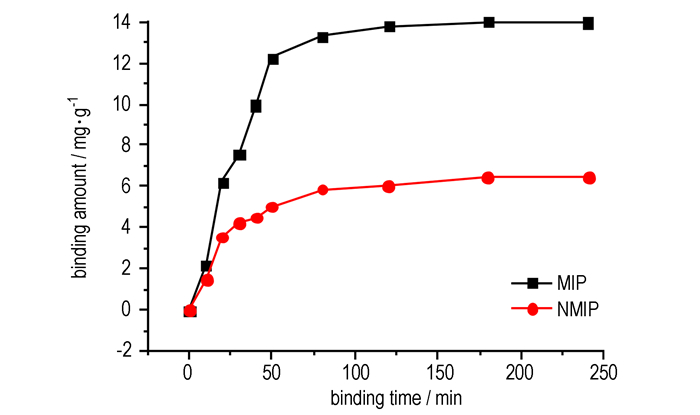
|
图 7 CL-20印迹聚合物和非印迹聚合物的吸附动力学曲线 Fig.7 Adsorption dynamic curves of CL-20 to MIP and NMIP |
图 8和图 9分别为CL-20分子印迹聚合物和非印迹聚合物的伪一级和伪二级动力学模型曲线。
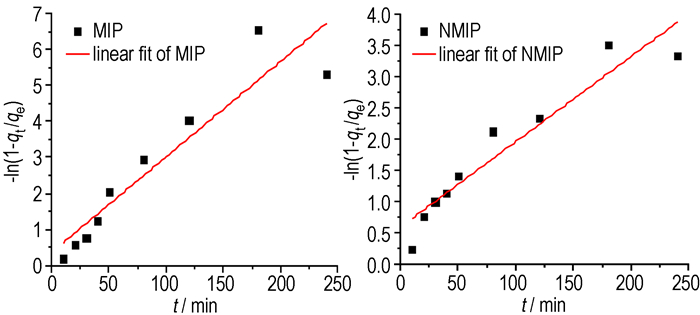
|
图 8 CL-20分子印迹聚合物和非印迹聚合物的伪一级动力学方程拟合结果 Fig.8 Fitting results of pseudo-first-order kinetic model of CL-20 MIP and NMIP |
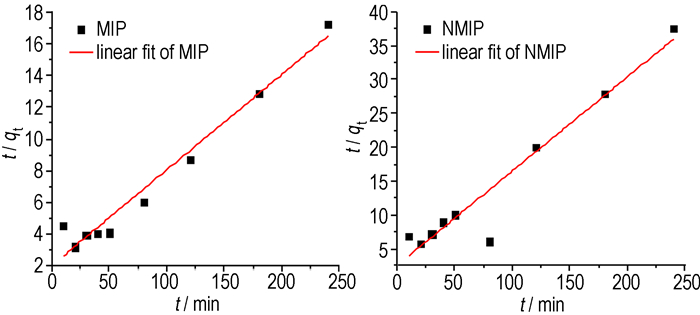
|
图 9 CL-20分子印迹聚合物和非印迹聚合物的伪二级动力学方程拟合结果 Fig.9 Fitting results of pseudo-second-order kinetic model of CL-20 MIP and NMIP |
| $ 伪一级动力学方程为:\ln ({q_e} - {q_t}) = {\rm{ln}}{q_e} - {k_1}t $ | (4) |
| $ 伪二级动力学方程为: \frac{t}{{{q_{\rm{t}}}}} = \frac{1}{{{k_2}q_{\rm{e}}^{\rm{2}}}} + \frac{t}{{{q_{\rm{e}}}}} $ | (5) |
式中, qe为平衡吸附量, mg·g-1; qt为t时刻的吸附量, mg·g-1; k1和k2分别为伪一级、伪二级速率常数, g·(mg·min)-1。
由表 3和表 4结果可知, 伪二级动力学方程的相关系数大于一级反应的相关系数, 说明印迹聚合物对CL-20的吸附反应更符合伪二级反应。
| 表 3 伪一级动力学参数拟合 Tab.3 Parameters fitting of pseudo-first-order kinetic model |
| 表 4 伪二级动力学参数拟合 Tab.4 Parameters fitting of pseudo-second-order kinetic model |
为了研究CL-20-MIP的吸附选择性, 选择RDX、TNT作为竞争分子进行比较。通过静态平衡吸附测定聚合物对这三种目标吸附物的吸附量, 结果如表 5。由表 5可见, CL-20-MIP对CL-20的吸附量明显高于RDX和TNT, CL-20-MIP表现出较好的选择性。而NNIP对三种底物的吸附量都相对较小, 主要原因是MIP内部存在与模板分子CL-20在形状、尺寸和功能上互补的分子印迹孔穴, 以及与CL-20分子形成相互作用的结合位点, 在印迹孔穴和结合位点共同作用下, MIP对CL-20具有选择识别性能。
| 表 5 不同底物在聚合物上的吸附量 Tab.5 Adsorption of different substrates on polymer |
(1) 以CL-20为模板, 在CL-20:AM:TRIM摩尔比为1:7:20, 致孔剂乙腈用量为62.5 mL时, 采用沉淀聚合法制备了CL-20印迹聚合物。
(2) 对紫外吸收光谱的分析证实了CL-20与功能单体AM之间存在相互作用。用扫描电子显微镜观察了印迹聚合物的微观形貌, 所得的印迹聚合物是分散性较好, 粒径约为1 μm的微球。
(3) CL-20印迹聚合物的吸附性能和识别性能。实验结果表明, 在1 mmol·L-1的CL-20/乙醇溶液中, 印迹聚合物和非印迹聚合物的平衡吸附量分别为14.02 mg·g-1和6.77 mg·g-1。选择性吸附实验表明, 印迹聚合物具有识别能力。
(4) 吸附热力学实验表明, CL-20-MIP和NMIP微球的吸附性能相对较好地符合Freundlich吸附等温线。吸附动力学实验表明, 印迹聚合物对CL-20的吸附符合伪二级动力学模型。
| [1] |
LUO Xu-biao, ZHAN You-cai, HUANG Yi-ning, et al. Removal of water-soluble acid dyes from water environment using a novel magnetic molecularly imprinted polymer[J].
Journal of Hazardous Materials, 2011, 187(1-3): 274-282. DOI:10.1016/j.jhazmat.2011.01.009 |
| [2] |
Sueyoshi Y, Fukushima C, Yoshikawa M. Molecularly imprinted nanofiber membranes from cellulose acetate aimed for chiral separation[J].
Journal of Membrane Science, 2010, 357(1-2): 90-97. DOI:10.1016/j.memsci.2010.04.005 |
| [3] |
Otero-Romani J, Moreda-Piñeiro A, Bermejo-Barrera P, et al. Ionic imprinted polymer for nickel recognition by using the bi-functioalized 5-vinyl-8-hydroxyquinoline as a monomer: Application as a new solid phase extraction support[J].
Microchemical Journal, 2009, 93(2): 225-231. DOI:10.1016/j.microc.2009.07.011 |
| [4] |
Barahona F, Turiel E, Martín-Esteban A. Supported liquid membrane-protected molecularly imprinted fibre for solid-phase microextraction of thiabendazole[J].
Analytica Chimica Acta, 2011, 694(1-2): 83-89. DOI:10.1016/j.aca.2011.03.052 |
| [5] |
Yoshikawa M, Tanioka A, Matsumoto H. Molecularly imprinted nanofiber membranes[J].
Current Opinion in Chemical Engineering, 2011, 1(1): 18-26. DOI:10.1016/j.coche.2011.07.003 |
| [6] |
Alizadeh T, Ganjali M R, Zare M, et al. Selective determination of chloramphenicol at trace level in milk samples by the electrode modified with molecularly imprinted polymer[J].
Food Chemistry, 2012, 130(4): 1108-1114. DOI:10.1016/j.foodchem.2011.08.016 |
| [7] |
Shakerian F, Dadfarnia S, Shabani A M H. Synthesis and application of nano-pore size ion imprinted polymer for solid phase extraction and determination of zinc in different matrices[J].
Food Chemistry, 2012, 134(1): 488-493. DOI:10.1016/j.foodchem.2012.02.105 |
| [8] |
Rebelo T S C R, Almeida S A A, Guerreiro J R L, et al. Trimethoprim-selective electrodes with molecularly imprinted polymers acting as ionophores and potentiometric transduction on graphite solid-contact[J].
Microchemical Journal, 2011, 98(1): 21-28. DOI:10.1016/j.microc.2010.10.006 |
| [9] |
LEI Jian-du, TAN Tian-wei. Enantioselective separation of naproxen and investigation of affinity chromatography model using molecular imprinting[J].
Biochemical Engineering Journal, 2002, 11(2-3): 175-179. DOI:10.1016/S1369-703X(02)00022-0 |
| [10] |
HUAI Lu-feng, YANG Ming, LIU Jun, et al. Synthesis and characterization of molecularly imprinted polymer microspheres for recognition of chlorpyrifos[J].
Chinese Journal of Applied Chemistry, 2009, 26(10): 1144-1148. |
| [11] |
Sambe H, Hoshina K, Haginaka J. Molecularly imprinted polymers for triazine herbicides prepared by multi-step swelling and polymerization method: Their application to the determination of methylthiotriazine herbicides in river water[J].
Journal of Chromatography A, 2007, 1152(1-2): 130-137. DOI:10.1016/j.chroma.2006.09.003 |
| [12] |
ZHANG Li-yong, CHENG Guo-xiang, FU Cong. Molecular selectivity of tyrosine-imprinted polymers prepared by seed swelling and suspension polymerization[J].
Polymer International, 2002, 51(8): 687-692. DOI:10.1002/(ISSN)1097-0126 |
| [13] |
Beltran A, Marcé R M, Cormack P A G, et al. Synthesis by precipitation polymerisation of molecularly imprinted polymer microspheres for the selective extraction of carbamazepine and oxcarbazepine from human urine[J].
Journal of Chromatography A, 2009, 1216(12): 2248-2253. DOI:10.1016/j.chroma.2009.01.024 |
| [14] |
TAN Jia-jin, JI Guang-fu, CHEN Xiang-rong, et al. Structure, equation of state and elasticity of crystalline HNIW by molecular dynamics simulations[J].
Physica B: Condensed Matter, 2011, 406(15-16): 2925-2930. DOI:10.1016/j.physb.2011.03.062 |
| [15] |
杜文霞, 刘亚杰, 王玉玲, 等. 六硝基六氮杂异伍兹烷的致突变性和致畸性研究[J].
中华劳动卫生职业病杂志, 2007, 25(1): 41-42. DU Wen-xia, LIU Ya-jie, WANG Yu-ling, et al. Mutagenicity and teratogenicity of hexanitrohexaazaisowurtzitane[J]. Chinese Journal of Industrial Hygiene and Occupational Diseases, 2007, 25(1): 41-42. |
| [16] |
陈松林, 刘家彬, 尉淑琼, 等. 六硝基六氮杂异伍兹烷的热分解反应动力学研究[J].
含能材料, 2002, 10(1): 46-48. CHEN Song-lin, LIU Jia-bin, WEI Shu-qiong, et al. Study on Thermal Decomposition Kinetics of Hexanitrohexaazaisowurtzitane[J]. Chinese Journal of Energetic Materials(Hanneng Cailiao), 2002, 10(1): 46-48. |
| [17] |
CHEN Jyh-ping, SU Da-rong. Latex particles with thermo-flocculation and magnetic properties for immobilization of α-Chymotrypsin[J].
Biotechnology Progress, 2001, 17(2): 369-375. DOI:10.1021/bp010001a |

CL-20 molecularly imprinted polymer(MIP) microspheres were prepared via precipitation polymerization with CL-20 as template, acrylamide as functional monomer, trimethylolpropane triacrylate as crosslinking agent, acetonitrile as solvent and porogen and AIBN as initiatives using molecularyly imprinted technology (MIT). T he optimum synthetic conditions were obtained.



